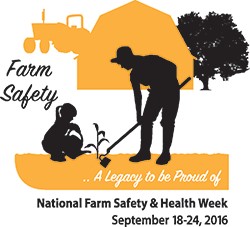Good Day’s Work is excited to celebrate National Farm Safety Week this year, and we hope that you will do what you can to join us in our mission to promote a safer environment in agriculture. Farm injuries and fatalities are preventable through education, and this awareness week serves as a good reminder to rural communities that agriculture is one of the most dangerous occupations in the U.S.

The theme “Farm Safety…A Legacy to be Proud of ” reminds local and rural communities that agriculture is one of the most dangerous occupations in the U.S. The most recent data from the U.S. Department of Labor indicates that in 2014 farming accounted for 568 fatalities, with an estimated 70,000 injuries.
Third Week of September - National Farm Safety & Health Week
Each year since 1944, the third week of September has been recognized as National Farm Safety & Health Week. Over the years, the development and dissemination of National Farm Safety & Health Week materials shifted from the National Safety Council to NECAS (National Education Center for Agricultural Safety). NECAS is the agricultural partner for the National Safety Council and has been serving the agricultural family and business community since 1997.
As we recognize National Farm Safety & Health Week this September, please join us in promoting safe and healthy practices on our farms and ranches across the U.S. and in our neighboring countries as producers enter the harvest season.
Most Dangerous Jobs
These jobs had the highest rate of fatalities per 100,000 workers in 2014, the most recent year for which data is available:
- Logging workers, 109.5
- Fishers and related fishing workers, 80.8
- Aircraft pilots and flight engineers, 63.2
- Roofers, 46.2
- Refuse and recyclable material collectors, 35.8
- Farmers, ranchers, and other agricultural managers, 26.0
- Structural iron and steel workers, 25.2
- Driver/sales workers and truck drivers, 23.4
- Electrical power-line installers and repairers, 19.2
- First-line supervisors of construction trades and extraction workers, 17.9
Source: U.S. Bureau of Labor Statistics


